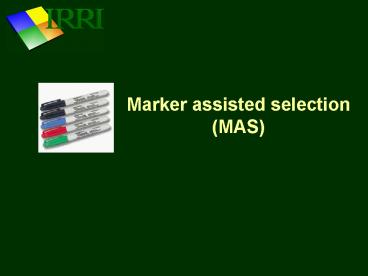Marker assisted selection MAS - PowerPoint PPT Presentation
1 / 24
Title: Marker assisted selection MAS
1
Marker assisted selection(MAS)
2
Difficulties of using MAS
- Still a relatively high cost technology
- Difficult to apply in population sizes used by
breeders (1 million genotypes grown per year) - For many traits the desirable genes (alleles)
have not been identified - QTLs for important traits often have small
effects or markers are not close enough to the
gene of interest
3
How do we attain the next breakthroughs in rice
breeding?
- In many areas of South and Southeast Asia,
widely-grown varieties with favorable features
are rare achievements - Many newly released varieties, while often
showing superiority in breeders tests, do not
replace the existing varieties
4
These varieties are each grown on millions of
hectares
Samba Mahsuri
Mahsuri
Khao Dawk Mali 105
Swarna
RD6
IR64
CR1009
BR11
5
Marker assisted backcrossing (MAB)
- Approach to rapidly introduce a favorable gene
into a superior genetic background (widely grown
variety or variety with rapidly expanding area) - Smaller population sizes that are easier to
handle with markers - Clear advantage over conventional approach in
speed of product development
6
Targets for MAB
Mahsuri
Swarna
7
Number of individuals to obtain desiredgenotype
in following BC generation (q0.99)
FL1
FL2
R
FL1
FL2
R
d1
d2
d1
d2
d (cM)
From Frisch, Bohn Melchinger 1999
8
Backcross F1 (BC1F1)
Recurrent parent
Donor
9
NIL (near isogenic line) (BC4F1)
Recurrent parent
Donor
10
(BC2F2)
Recurrent parent
Donor
11
MAB for Sub1
12
Graphical genotypes of a MAB population
Swarna allele
Donor allele heterozygote
Sub1
13
Individual withhighest Swarna alleles (242)
14
Chromosome 9of individual 242
Sub1
15
Timeline for MAB products
0
1
Recombination/background
BC2F1
Recombination/background
BC2F2
Background
2
16
What we need for MAB
- Donor with a QTL or major gene that adds
significant value - Target cultivar or breeding line of high value
- Closely linked markers (flanking markers and
cosegregating marker)
17
Target QTLs for Abiotic Stress Tolerance
Approximate map position based on
18
P uptake
12
Pup1 LOD 16.5 R2 78.8
From Wissuwa Ismail
19
Fine mapping salinity tolerance gene
Chromosome 1
58.1
RM23
60.6
AP3206-124201
62.5
AP4253-20757,RM3412
63.9
AP3722-9700
Saltol gene
64.9
RM140, S13927/AluI
65.4
AP3211-28
66.5
CP10135
67.6
AP2869-104052, AP2869-17620, RM8115
67.9
AP3143-072/DraI
73.7
RM113,RM24
LOD 6.7 R2 43.9
From G. Gregorio
20
Cold tolerance
4
LOD 8.36, R2 20.8
12
LOD 20.34, R2 40.6
From Andaya Mackill 2003
21
Al toxicity
Nguyen, Brar
22
MAS in GAMMA
High-throughput mini prep DNA extraction
Lyophilize leaf samples
Add stainless steel balls
Place samples in 96 deep well plates
Use GenoGrinder to pulverize samples
Use automated liquid dispenser for DNA extraction
23
High throughput manual SSR genotyping
High throughput automated genotyping using
fluorescently labeled primers
24
GAMMA lab genotypers































